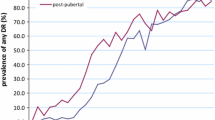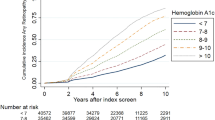Summary
In our preceding paper, the prevalence and development of retinopathy in 231 Type 1 diabetic children and adolescents were reported to be associated with the duration of diabetes and its age at onset. This paper analyses the relationships between the development of retinopathy and the following factors: age, sex, puberty, blood pressure, insulin dosage, HLA antigens, long-term glycaemic control, and serum cholesterol and triglycerides. All these variables were longitudinally evaluated in a cohort of 322 insulin-dependent patients aged 16.2 ± 4.9 years with diabetes for 7.4 ± 5.2 years, including those 231 subjects whose eyes were examined once or repeatedly by ophthalmoscopy and fluorescein angiography. Long-term glycaemic control from the onset of diabetes to the retinal examination was assessed by both an arbitrary score comprising different parameters and by mean values of glycosylated haemoglobin, and was categorised as good, fair, and poor. With life-table analysis, the overall median individual risk for developing early retinal changes (9.1 years) was found to be significantly influenced by glycaemic control. Minimal lesions developed earlier (8.0 years) with poor control, but later with fair (10.5 years) and good glycaemic control (12.5 years) (p < 0.01). Mean HbA1 values below 10% delayed the onset of both incipient (10.8 years) and background retinopathy (16.6 years), while values above 10% advanced it (8.0 and 11.8 years respectively) (p < 0.05 and < 0.008). By multivariate regression and stepwise discrimination analyses, only 4 out of 14 variables were found to exert significant independent influences on the development of retinopathy: diabetes duration, long-term glycaemic control, serum triglycerides and age. The correlation coefficients with retinopathy cumulatively increased fromr=0.78 for duration of diabetes only tor=0.81 for the sum of these four factors. None of the other variables was found to increase this value any further.
Similar content being viewed by others
References
Tanner JM (1955) Growth at adolescence. Blackwell, Oxford
Siegenthaler W (ed) (1976) Klinische Pathophysiologie. Thieme, Stuttgart, p 617
Constam GR (1971) Contrôle du diabète et prevention des complications. Journées Diabétol. Hotel Dieu Paris, p 313–320
Carpenter RG, Taylor KW (1963) Statistical methods for examining retinopathy in relation to the control of diabetes and other factors. Br J Ophthalmol 47: 590–595
Nie NH, Hull CH, Jenkins JG, Steinbrenner K, Bent DH (1975) SPSS — Statistical package for the social sciences, 2nd edn. McGraw-Hill, New York
Siperstein MD, Unger RH, Madison LL (1968) Studies of muscle capillary basement membranes in normal subjects, diabetic and prediabetic patients. J Clin Invest 47: 1973–1999
Pirart J (1977) Diabete et complications dégénératives. Presentation d'une etude prospective portant sur 4400 cas observe entre 1947 et 1973. Diabete Metab 3: 97–107, 173–182, 245–256
Tchoubroutsky G (1978) Relation of diabetic control to development of microvascular complications. Diabetologia 15: 143–152
West KM (1982) Hyperglycemia as a cause of long-term complications. In: Keen H, Jarret J (eds) Complications of diabetes. Edward Arnold, London, pp 13–18
Drash AL, Lobes L, Becker D, Grand G (1981) Factors affecting retinopathy in children with diabetes mellitus. In: Weber B (ed) Diabetic angiopathy in children. Pediatr Adolesc Endocrinol Karger, Basel, Vol 9, p 210–214
Frank RN, Hoffmann WH, Podgor MJ, Joondeph HC, Lewis RA, Mergherio RR, Nachazel DP jr, Weiss H, Christopherson KW, Cronin WA (1982) Retinopathy in juvenile-onset type I diabetes of short duration. Diabetes 31: 874–882
Greite JH, Hertel JW, Mörchen H (1976) Evaluation of diabetic retinopathy. Doc ophthalmol proc ser: International symposium of fluorescein angiography. Dr. W Junk b.v. Publishers, The Hague, p 515–521
Lestradet H, Papoz L, Hellouin de Menibus C, Levasseur C, Besse F, Billaud L, Batistelli F, Tric P, Lestradet F (1981) Long-term study of mortality and vascular complications in juvenile onset (type I) diabetes. Diabetes 30: 175–179
Barbosa J, Ramsey R (1980) Genetic contribution to retinopathy. Diabetologia 18: 515
Nerup J, Christy M, Kroman H, Andersen OO, Platz P, Ryder LP, Thomsen M, Svjegaard A (1980) Genetic susceptibility and resistance to IDDM. In: Irvine WJ (ed) Immunology of diabetes. Teviot, Edinburgh, p 55–66
Doman TL, Ting A, McPherson CK, Peckar CO, Mann JI, Turner RC, Morris PJ (1982) Genetic susceptibility to the development of retinopathy in insulin-dependent diabetics. Diabetes 31: 226–231
Brooser G, Barta L, Anda L, Molnar M (1975) Frühdiagnose der Mikroangiopathie bei kindlichem Diabetes. Klin Monatsbl Augenheilk 166: 233–236
Deckert T (1981) Compilation of fluorescein angiographic data. In: Weber B (ed) Diabetic angiopathy in children. Pediatric and Adolescent Endocrinology, vol 9. Karger, Basel, p 232–235
Dorchy H, Toussaint D, Haumom D, Loeb H (1983) Relationship between some clinical and biological factors and incipient diabetic retinopathy diagnosed by fluorescein angiography. Am J Ophthalmol 96:108–110
Hürter P, Bernsau I, Gilde K, Hoffmann K, Jost J (1981) Fluorescein angiographic studies in 90 diabetic children and adolescents. In: Weber B (ed) Diabetic angiopathy in children. Pediatric and Adolescent Endocrinology, vol 9. Karger, Basel, p 223–225
Jackson RL, Ide CH, Guthrie RA, James RD (1982) Retinopathy in adolescents and young adults with onset of IDDM in childhood. Ophthalmology 89: 7–13
Malone JI (1981) Factors influencing microvascular disease in children with diabetes. In: Weber B (ed) Diabetic angiopathy in children. Pediatric and Adolescent Endocrinology, vol 9. Karger, Basel, p 205–209
Glasgow AM, August GP, Hung W (1981) Relationship between control and serum lipids in juvenile onset diabetes. Diabetes Care 4: 76–80
Adlersberg D, Wang CI, Rifkin H, Berkman J, Ross G, Weinstein C (1956) Serum lipids and polysaccharides in diabetes mellitus. Diabetes 5: 116–120
Dornan TL, Carter RD, Brou AJ, Turner RC, Mann JI (1982) Low-density lipoprotein cholesterol: An association with severity of retinopathy. Diabetologia 22: 167–170
Keiding NR, Mann GV, Root HF, Lawry EY, Marble A (1952) Serum lipoproteins and cholesterol levels in normal subjects and in young patients with diabetes in relation to vascular complications. Diabetes 1: 434–440
Kissebah AH, Kohner EM, Lewis B, Sidding YK, Lowy C, Fraser TR (1975) Plasma-lipids and glucose-insulin relationship in noninsulin-requiring diabetics with and without retinopathy. Lancet 1: 1104–1108
Sterky G, Larsson Y, Persson B (1963) Blood lipids in diabetic and non-diabetic schoolchildren. Acta Paediatr 52: 11–21
Ditzel J, Moinat P (1959) Changes in serumproteins, lipoproteins and protein-bound carbohydrates in relation to pathologic alterations in the microcirculation of diabetic subjects. J Lab Clin Med 54:843–859
Goldberg RB (1981) Lipid disorders in diabetes. Diabetes Care 4: 561–572
Author information
Authors and Affiliations
Rights and permissions
About this article
Cite this article
Weber, B., Burger, W., Hartmann, R. et al. Risk factors for the development of retinopathy in children and adolescents with Type 1 (insulin-dependent) diabetes mellitus. Diabetologia 29, 23–29 (1986). https://doi.org/10.1007/BF02427276
Received:
Revised:
Issue Date:
DOI: https://doi.org/10.1007/BF02427276




